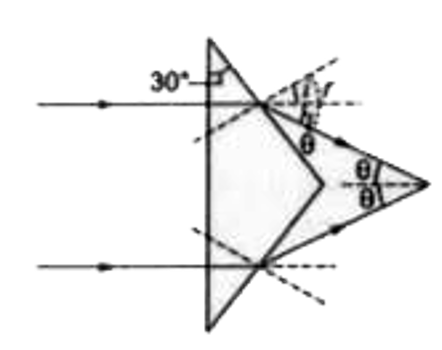Refracted ray from an equilateral prism will be parallel to surface is incidence angle is ....... (μ=1.5)Solution in Gujrati
28∘
38∘
48∘
82∘
The correct Answer is:A, B
If r2=C (Critical angle), then refracted ray will be parallel to AC.
∴n=1sinC
∴sinC=1n=11.5=0.6667
∴C=41∘48∘
∴r2=41∘48.
Now,A=r1+r2
∴r1=A−r2
=60∘−41∘48.
∴r1=18∘12.

Now using Snell.s law for AB, n = sinisinr1
∴sini=n×sinr1
=1.5×sin∘13.
=1.5×0.3123=0.4684
∴i=28∘
Topper's Solved these Questions
- BOOK - KUMAR PRAKASHANCHAPTER - RAY OPTICS AND OPTICAL INSTRUMENTSEXERCISE - SECTION-D (MULTIPLE CHOICE QUESTIONS (MCQs))(MCQs FROM .DARPAN. BASED ON TEXTBOOK)(NATURAL PHENOMENA DUE TO SUN LIGHT )11videos
RAY OPTICS AND OPTICAL INSTRUMENTS
- BOOK - KUMAR PRAKASHANCHAPTER - RAY OPTICS AND OPTICAL INSTRUMENTSEXERCISE - SECTION-D (MULTIPLE CHOICE QUESTIONS (MCQs))(MCQs FROM .DARPAN. BASED ON TEXTBOOK)(OPTICAL INSTRUMENTS)13videos
RAY OPTICS AND OPTICAL INSTRUMENTS
- BOOK - KUMAR PRAKASHANCHAPTER - RAY OPTICS AND OPTICAL INSTRUMENTSEXERCISE - SECTION-D (MULTIPLE CHOICE QUESTIONS (MCQs))(MCQs FROM .DARPAN. BASED ON TEXTBOOK)(REFRACTION, MAGNIFICATION, POWER AND COMBINATION OF LENS)29videos
RAY OPTICS AND OPTICAL INSTRUMENTS
- BOOK - KUMAR PRAKASHANCHAPTER - MOVING CHARGES AND MAGNETISMEXERCISE - SECTION D (MCQs ASKED IN COMPETITIVE EXAMS)34videos
MOVING CHARGES AND MAGNETISM
- BOOK - KUMAR PRAKASHANCHAPTER - SAMPLE QUESTION PAPER EXERCISE - PART-B SECTION-C5videos
SAMPLE QUESTION PAPER
Similar Questions
In which phenomenon, white light gets divided into its element colours ?
03:51View SolutionOne cannot see through the fog, because …..... .
03:23View SolutionLight rays emerge from denser medium (n2), refract from curved surface and then travel through rarer medium (n1), formula for this is ….........
01:20View SolutionElectric charge Q having mass M moves on a circular path of radius R with velocity →v, perpendicular to uniform magnetic field B. When a particle completes one revolution, work done by the field is _______
02:00View SolutionTwo charges –q and +q are located at points (0, 0, –a) and (0, 0, a), respectively.
(a) What is the electrostatic potential at the points (0, 0, z) and (x, y, 0) ?
(b) Obtain the dependence of potential on the distance r of a point from the origin when r/a>>1 .
(c) How much work is done in moving a small test charge from the point (5,0,0) to (–7,0,0) along the x-axis? Does the answer change if the path of the test charge between the same points is not along the x-axis?View SolutionThe refracting angle of a glass prism is 30^@. A ray is incident onto one of the faces perpendicular to it. Find the angle delta between the incident ray and the ray that leaves the prism. The refractive index of glass is mu=1.5.
03:30View SolutionWhen a ray of light is incident normally on one refracting surface of an equilateral prism (Refractive index of the material of the prism =1.5
02:41View SolutionA ray of light incident on an equilateral triangular glass prism of mu = sqrt(3) moves parallel to the base of the prism inside it. What is the angle of incidence for this ray ?
04:20View SolutionA ray of light is incident on a refracting face of glass prism of refracting angle 30^@ . If the ray emerges normally from the second refracting surface, the angle of incidence is refracting surface, the angle of incidence is [""_(a)mu_(g) = 1.5]
05:57View SolutionThe refracting angle of an equilateral prism is A. Derive an expression for the angle of deviation for a ray of light incident on the refracting surface of the prism. Draw a neat curve to show the variation of deviation with angle of incidence of the incident ray.
04:51View SolutionA ray of light is incident normally on one refracting surface of an equilateral prism . If the refrctive index of a material of the prism is 1.5., then
02:27View SolutionThere is an equilateral prism of material of refractive index 1.5. Light ray is incident normally on its surface. What will be the angle of deviation of ray ?
View Solutionएक प्रिज्म के अपवर्तक पृष्ठ पर कोण θ पर आपतित प्रकाश की किरण सामान्यतः दूसरे पृष्ठ से निर्गत होती है। यदि प्रिज्म का कोण 5∘ है तथा प्रिज्म अपवर्तनांक 1.5 के पदार्थ का बना है, तो आपतन कोण (Angle of incidence) होगा -
02:43View Solutionदो समान्तर प्रकाश किरणें एक प्रिज्म के एक पृष्ठ पर आपतित होती है। प्रिज्म का अपवर्तनांक 1.5 है। निकलने वाली किरणों के बीच कोण है
 03:34View Solution
03:34View Solutionअपवर्तनांक √3 के एक समबाहु प्रिज्म में आपतन कोण θ के लिए प्रिज्म में अपवर्तित किरण, आधार के समांतर होती है | θ का मान होगा
01:43View Solution

